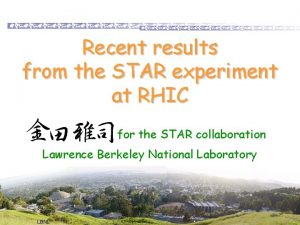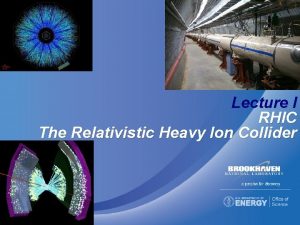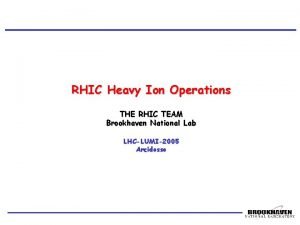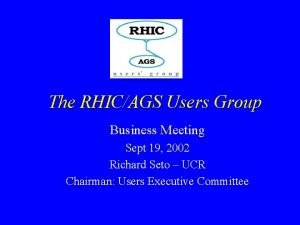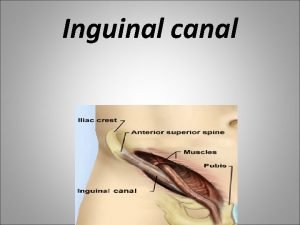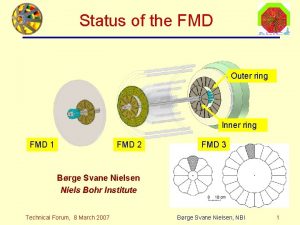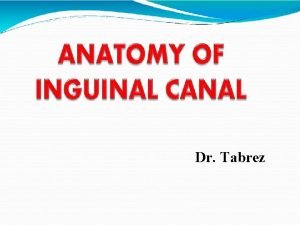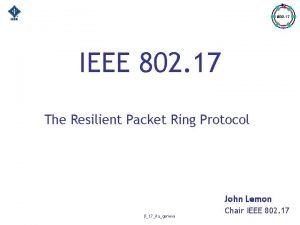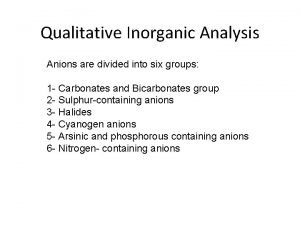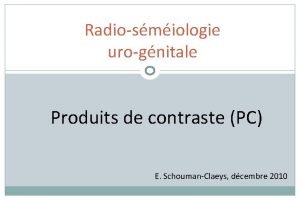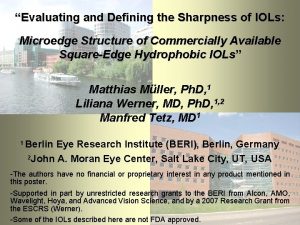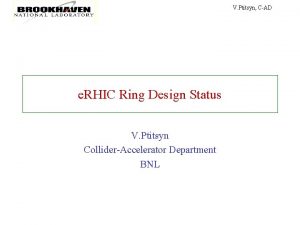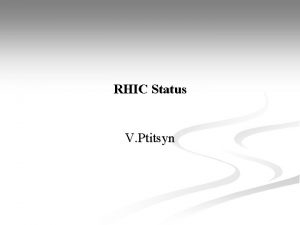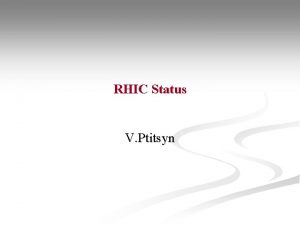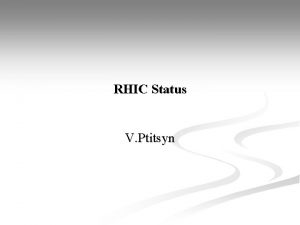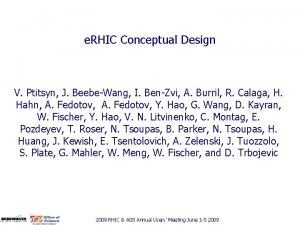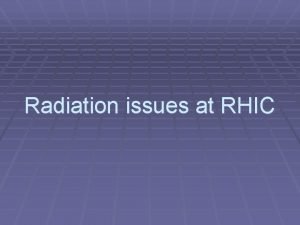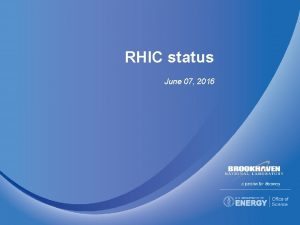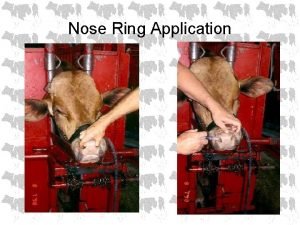e RHIC with SelfPolarizing Electron Ring V Ptitsyn














- Slides: 14

e. RHIC with Self-Polarizing Electron Ring V. Ptitsyn, J. Kewisch, B. Parker, S. Peggs, D. Trbojevic, BNL, USA D. E. Berkaev, I. A. Koop, A. V. Otboev, Yu. M. Shatunov, BINP, Russia C. Tschalaer, J. B. van der Laan, F. Wang, MIT-Bates, USA D. P. Barber, DESY, Hamburg, Germany

A. Deshpande The EIC w. r. t. Other Experimental Facilities TESLA-N Large luminosity and high CM Energy makes EIC unique! Variable CM energy enhances its versatility!

EIC Objectives § e-p and e-ions collisions § 5 -10 Ge. V electrons; 25 -250 Gev protons; 100 Gev/u Au § Luminosity: Ø L = (0. 3 -1)x 1033 for e-p collisions Ø L = (0. 3 -1)x 1031 for e-Au collisions § Polarized electron and proton beams § Longitudinal polarization at collision point; 70% § 35 nsec minimum separation between bunches

Polarized Proton in RHIC p. C Polarimeters BRAHMS & PP 2 PP (p) Absolute Polarimeter (H jet) PHENIX (p) STAR (p) Siberian Snakes Spin Rotators Pol. Proton Source 500 m. A, 300 ms Partial Siberian Snake Strong AGS Snake LINAC BOOSTER 200 Me. V Polarimeter Rf Dipoles AGS 2 1011 Pol. Protons / Bunch e = 20 p mm mrad AGS Internal Polarimeter AGS p. C Polarimeters

e. RHIC collider layout 2 Ge. V (5 Ge. V) e 2 -10 Ge. V IP 12 RHIC p 50 -250 Ge. V Au 100 Gev/u p • • • e-ring is 5/16 of RHIC ring Collisions at one IP 28 MHz collision rate Unpolarized electron source Electron beam polarization by the synchrotron radiation • e-ring lattice based on ”superbend” magnets

Superbend magnet B, T 2 10 Ge. V 5 Ge. V 0. 57 0. 2 The desired balance: short polarization time at the acceptable level of synchrotron radiation losses Flexible control of the beam emittance Issues: 0. 15 m 3 m • • Accomodation of radiated power (7 MW radiated at 10 Ge. V) Orbit lengthening versus beam energy

Polarization time with superbend • Magnet bending field scaled proportionally with energy • The superbend control of polarization time. 8 -15 min polarization time is achievable.

Luminosity and beam-beam limits Reasonably achievable values: 0. 05 0. 005 Ø Round beams: nx=ny , bx=by for electrons Ø Matching of the e and p beam sizes is crucial.

Beam emittance control Electron emittance versus electron energy for different superbend settings e-cool zone Ee=10 Ge. V • • • Ee=5 Ge. V Required normalized emittances for Au: 5 -8 Pi mm*mrad at 5 -10 Ge. V electron energies; The cooling is required. Cooling of the proton beam is required for proton energies below 200 Ge. V Electron cooling system for RHIC is being developed.

Main beam parameters ion ring Parameters e-ring p C, m 1022 E, Ge. V 5– 10 nb 96 Nb 1 1011 I, A erms, mm rad b*, cm s*, mm x 0. 45 45– 25 10 0. 07– 0. 05 L, cm-2 s-1 Au 3833 250 100/u 360 1 1011 1 109 0. 45 17– 9 27 0. 07– 0. 05 0. 005 (0. 5 -0. 9) 1033 (0. 5 -0. 9) 1031

Polarization issues Depolarization from ring imperfections in the e-ring • 0. 5 mm rms closed orbit error assumed. • The correction scheme similar to the one used at HERA should solve the problem. • Fast polarimeter for the on-line spin resonance corrections. The possibility to accelerate polarized light ions: deutrons, tritium, 3 He, 19 F (E. Courant). The polarized sources development is required.

IR Design Horizontal separation scheme • • Vertical separation scheme IR development proceeds in close link with the detector design Detector background and protection from synchrotron radiation issues

Spin rotator e-ring: solenoidal spin rotator -> simplest solution • Perfect longitudinal polarization at 7. 5 Ge. V ~15% reduction at 5 or 10 Ge. V. • Spin transparency conditions on optics Rotator design n solenoid quads n p-ring: Helical spin rotator like being used already at two RHIC experiments

Summary: q The design is based on the construction of a self-polarizing electron ring. q Polarized e-p and unpolarized e-ion beam collisions in the center of mass energy range of 30 -100 Gev and at luminosities up to 0. 9 x 1033 cm-2 s-1 for e-p and 0. 9 x 1031 cm-2 s-1 for e-Au collisions. q The electron polarization time of 8 -15 min is achieved with superbend magnets. q The collider design could be realized using the present level of the accelerator technology.
 Rhic
Rhic Rhic
Rhic Rhic brookhaven
Rhic brookhaven Rhic ags users meeting 2020
Rhic ags users meeting 2020 Strong no in c
Strong no in c Wise men gifts
Wise men gifts Inguinal region
Inguinal region Inner ring and outer ring
Inner ring and outer ring Flap valve mechanism of inguinal canal
Flap valve mechanism of inguinal canal Token ring and resilient packet ring
Token ring and resilient packet ring How are anions divided into groups
How are anions divided into groups Ring a ding ding dong christmas song
Ring a ding ding dong christmas song Dulce et decorum est rhyme scheme
Dulce et decorum est rhyme scheme Classification ring et messmer
Classification ring et messmer Soemmering ring
Soemmering ring
